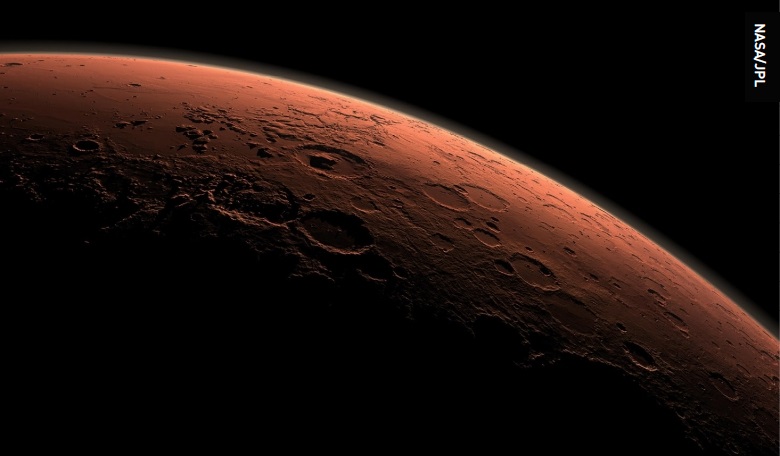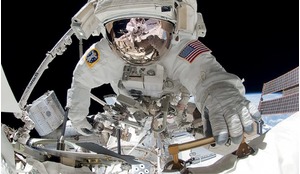Interplanetary flights and the colonisation of planets require solutions to the problems of protection from many space factors, including solar and galactic radiation, weightlessness during a long flight and hypogravity on extraterrestrial bases. In this article, Alexander Mayboroda proposes a number of solutions, including protection from space radiation provided by connecting spacecraft into a ‘package’ that forms a protective cocoon around their living quarters.
Flights to Mars and its colonisation are an integral part of the idea of a space expansion. The engineering project of the expedition to Mars (Das Marsprojekt) was prepared by Wernher von Braun in 1948 and became the first “technically comprehensive project” of such an expedition. It was published in 1952 under the title The Mars Project.
In the introduction to the project, von Braun admitted that his research was incomplete, because he had omitted details of some topics that would require further research, including the long-term effects of spaceflight on humans. Indeed, the dangers of high-energy solar and galactic radiation, as well as long-term weightlessness, were unknown in 1948, and further discoveries confirmed his assumptions.
 Fig. 1. Options for the radial construction of squadron ships in the Testudo package.
Fig. 1. Options for the radial construction of squadron ships in the Testudo package.
Crew protection
Flights to Mars and its colonisation are an integral part of the idea of a space expansion
There are still strong doubts about the possibility of flights to Mars before 2040. Interplanetary flights require not only rockets and spaceships, but also protection of the crew from cosmic radiation. As a result of the impact of the heavy charged particles of galactic rays on the brain, astronauts may lose their coordination and memory while going to Mars. For ample protection, it is required to provide the spaceship with a protective layer more than one metre thick, but this will lead to its excess mass and an unrealistic consumption of rocket fuel.
“People will definitely fly to Mars, but now we are not technologically ready for that. In the 2040s/50s, it will be possible to do this,” said Igor Mitrofanov, the head of the Department of Nuclear Planetology of the Space Research Institute of the Russian Academy of Sciences. He considers a quick flight to be a possible solution to the radiation problem, as an alternative to the protective layer.
A fast flight means that instead of 260 days, typical for the most economical Hohmann transfer, the flight time must be reduced to 90 or even 30 days. To do this, it is desirable to have a spaceship with nuclear engines, while at the same time reducing the cost by using reusable rockets.
At the 67th International Astronautical Congress in Guadalajara on 27 September 2016, Elon Musk, the head of SpaceX, presented a project for an interplanetary transport system involving the use of a reusable rocket to deliver people to Mars. The flight time to Mars would be about 90 days. However, even with an efficient transport system, SpaceX must solve many more problems related to preventing the negative effects of spaceflight factors, such as radiation, zero gravity and limited space for the crew, before the first flight to Mars.
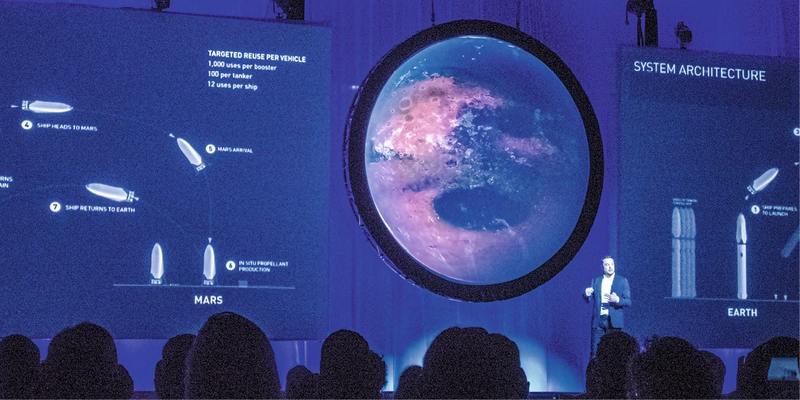 At the 67th International Astronautics Congress in Guadalajara, Mexico, in 2016, Elon Musk, head of SpaceX, presented a project for an interplanetary transport system involving the use of a reusable rocket to deliver people to Mars.
At the 67th International Astronautics Congress in Guadalajara, Mexico, in 2016, Elon Musk, head of SpaceX, presented a project for an interplanetary transport system involving the use of a reusable rocket to deliver people to Mars.
The problem of spacecraft entry and descent to Mars is difficult to solve and there is a risk that it will miss the narrow corridor of permissible deviations and either not slow down sufficiently and be deflected into interplanetary space or crash on the surface of Mars. The high rate of entry into the atmosphere requires highly reliable thermal protection and retro-braking rockets are probably required for deceleration into the Martian atmosphere.
There are still strong doubts about the possibility of flights to Mars before 2040
The NASA Institute for Advanced Concepts (NIAC) in Atlanta, Georgia, has funded a study to find out whether asteroids can be used in protection against radiation. A small group of asteroids regularly passes Earth and Mars and the project suggests that a spacecraft carrying astronauts to Mars could rendezvous with one of the asteroids when it passes the Earth and travel with it until it approaches the Red Planet.
In one version of the project, the ship lands on an asteroid and astronauts bury it in several metres of regolith to protect it from cosmic rays during the 6-10-month journey to Mars. However, it may not be easy to work with the material on the surface of asteroids due to static electricity. It is expected that ultraviolet light from the Sun will cause an accumulation of electric charge on the surface of asteroids, which can lead to material sticking to mechanisms and other hardware. Another problem is that it is necessary to adjust the speed of the ship’s departure from Earth to the actual speed of asteroid, which may be far from optimal. Therefore, the search for new ways of protection must continue.
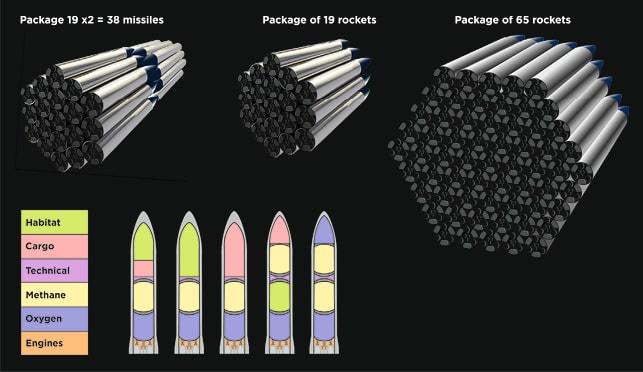 Fig. 2.1. Options for parallel construction of Testudo packages and the location of rocket compartments. Package19 × 2 = 38 missiles.
Fig. 2.1. Options for parallel construction of Testudo packages and the location of rocket compartments. Package19 × 2 = 38 missiles.
The Testudo project
The plan for flights to Mars developed by SpaceX provides for the dispatch of a squadron of 100 ships in the first phase to up to 1000 ships in a decade. Musk has stated that he plans to send one million people to Mars by 2050 and that SpaceX will build a fleet of 1000 Starships to transport them there. He also asserts that, in the next 10 years, SpaceX will build 1000 reusable Dragon crew spacecraft (100 vehicles per year) at the company’s plant in Texas. SpaceX plans to send spaceships with passengers to Mars about once every 26 months.
Thus, due to the large number in the squadron, it is possible to send spaceships to Mars in a large and compact group, arranging them so that they protect each other against radiation. With a high swarm density and the correct orientation of the ships, the living compartments can be effectively protected by multi-metre layers of fuel in the tanks. The low molecular weight of methane and oxygen increases the shielding efficiency.
The optimal configuration of the construction for 1000 ships is a sphere, the surface of which is formed by a ‘package’ of rockets in one or two layers, with their living compartments oriented towards the centre of the sphere. Such a defensive formation is similar to the formation of a Roman military detachment called testudo, or ‘turtle’. So it is reasonable to give the general name Testudo to the protective packages of rockets of various shapes.
The problem of spacecraft entry and descent to Mars is difficult to solve
Figure 1 entitled ‘Options for the radial construction of squadron ships in the Testudo package’ shows possible configurations of ship packages with large and small squadrons. To effectively use the two-layer sphere, which is not shown in the picture, the outer layer must be assembled from unpiloted vehicles that transport only fuel and cargo.
With a sufficiently dense formation of the squadron, collecting the package will require no more than a day, which will not lead to a significant dose of radiation. Theoretically, the package can be formed and fly without mechanical contact of the rockets and maintain a minimum distance due to the corrective work of a low-thrust rocket. However, a mechanical connection is preferable.
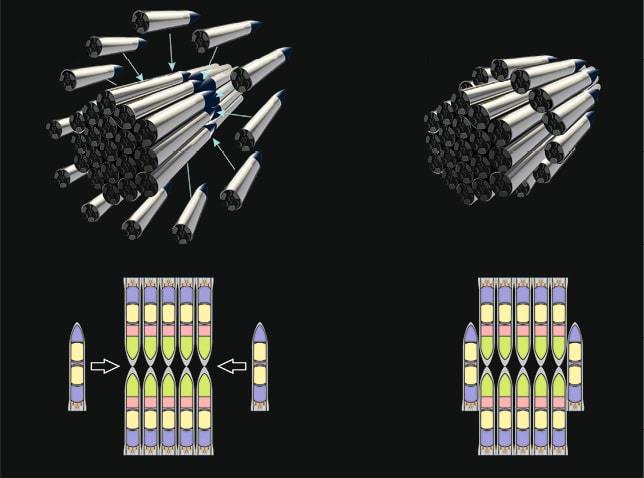 Fig. 2.2 Options of the Testudo package of 50 rockets: 19+19+12.
Fig. 2.2 Options of the Testudo package of 50 rockets: 19+19+12.
When approaching Mars, the package can be separated in a few hours. Each ship lands independently or enters orbit around the planet, where it is unloaded by a shuttle plying between the planet and orbit.
Effective protection of the crew from radiation makes it possible to return to the classic Hohmann trajectory when flying to Mars, which will significantly reduce fuel costs and the cost of the flight. Probably, some average optimal variant of the flight time to Mars will be chosen - perhaps between 88 and 259 days.
The flight of ships as part of a squadron assembled in a package has an additional advantage. Testudo allows a single cooling centre for cryogenic components of rocket fuel and, due to the effects of scale, will provide the maximum specific power unattainable for a single rocket. Through a network of gas pipelines connecting the fuel tanks of the rocket package, in which cooled helium gas circulates, the cryogenic centre will be able to store methane and oxygen in liquid form indefinitely.
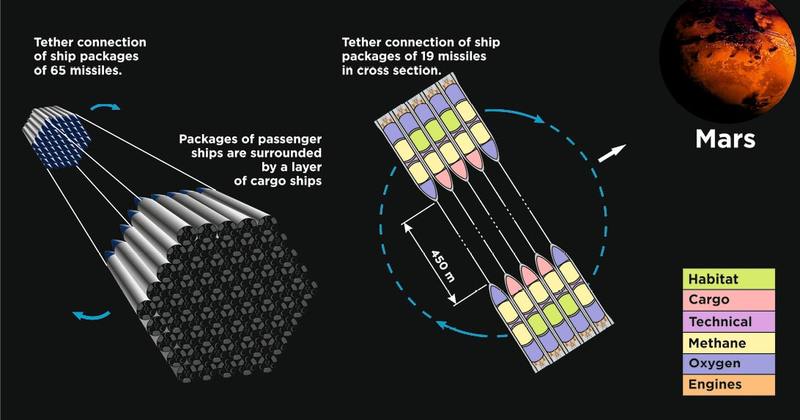 Fig. 3 Testudo packages with artificial gravity, showing a bundle of tethers of a package of ships untwisted to create artificial gravity. The force of artificial gravity can be chosen equal to that of Earth or Mars.
Fig. 3 Testudo packages with artificial gravity, showing a bundle of tethers of a package of ships untwisted to create artificial gravity. The force of artificial gravity can be chosen equal to that of Earth or Mars.
An advantage for passengers is that the limited volume of a spaceship’s living compartment is solved, because the compartments of all ships of the package are connected to increase not only the habitable space, but also the number of social contacts. This prevents the development of conflicts among small, isolated groups. The figure shows some options for parallel construction of Testudo packages and the location of the living compartments.
Werner von Braun, in his second, now almost forgotten project for an expedition to Mars (dated 12 November 1981), planned the creation of artificial gravity aboard the ships and nuclear-powered shuttles, taking ships on a flight path to Mars and then returning them to near-Earth orbit. However, in the project under consideration here, there is no need to use shuttles with nuclear engines, as thermochemical engines will suffice.
It may not be easy to work with the material on the surface of asteroids due to static electricity
Figure 3. ‘Testudo packages with artificial gravity’ shows a bundle of tethers of a package of ships untwisted to create artificial gravity. The force of artificial gravity can be chosen to equal that of Earth or Mars. The fuel tanks of the orbital colonies can serve as a fuel storage for cruising spaceships, while filling the tanks of the stations with water is also advisable. Water will be supplied from both Mars and its satellites. The satellites of Mars are also rich in carbon compounds, which are effective as radiation protection materials.
Starships that are out of flight resources can also be used to create settlements on the surface of Mars in the form of ring packages with artificial gravity. Technically, this is achievable by using ring trestles made of light lattice trusses. If Starship rockets are used to supply lunar bases, by the time the squadron is sent to Mars, there might have accumulated a sufficient stock of ships with almost depleted flight resources to use to build colonies both in orbit and on the surface.
 Fig. 4. Cylindrical city with artificial gravity.
Fig. 4. Cylindrical city with artificial gravity.
Artificial gravity
It is not enough to fly to Mars and land on it, because the weak gravity of Mars is arguably just as dangerous as prolonged weightlessness. The population of the planetary colonies living in ‘hypogravity’ will be at risk of acquiring various side effects due to the low gravity.
The damage to health in that case differs from the effects of weightlessness only by its delayed timing. Compact short-radius centrifuges, in which astronauts and colonists may periodically undergo quasi-gravity immersion sessions, unfortunately do not eliminate the negative consequences of weight loss, but only delay their onset.
The possibility of creating artificial gravity in planetary colonies has been previously shown in the ‘Gravity’ project. The first version of the project was presented at the end of 2013, but its significance for space expansion has only recently been realised. The Gravity project was proposed for a small long-term planetary base with a small number of personnel, although there are no fundamental restrictions on its expansion.
Figure 5., showing ‘A toroidal city with artificial gravity’ is a variant of the city for Mars. The analogue of the city is a rotating toroidal structure of an orbital colony.
 Fig. 5. A toroidal city with artificial gravity.
Fig. 5. A toroidal city with artificial gravity.
Expanding across space
It is possible to send spaceships to Mars in a large and compact group, arranging them so that they protect each other against radiation
The Testudo project shows the possibility of reducing the crew’s radiation dose not only by reducing the flight time when using energy-intensive near-parabolic trajectories, but also by creating effective anti-radiation protection with a long flight time along the economical Hohmann trajectory. The Testudo project is achievable by combining at least 19 Starship-type spacecraft into a package.
Testudo packages, consisting of out of use Starships, open up the possibility of building interplanetary fuel depots and large, radiation-protected, artificial gravity orbital stations near colonised planets.
Space settlements on the Moon, Mars, Ceres, Titan and other celestial bodies can be protected from hypogravity, as the rotation of residential settlement modules, that create artificial gravity, is possible not only in space, but also on planets at low cost compared to orbital settlements.
Regardless of the solution to the problem of protection of the population from hypogravity, centrifuge settlements could provide a method of space expansion across all small bodies of the solar system.
About the author
Alexander Mayboroda is CEO of AVANTA-consulting, Russia. He is a former director of Microgravitatcia research and technology centre, which worked under the aegis of the USSR Space Federation and the Research and Technology Society of the USSR on non-rocket space transport systems and using microgravity for industrial purposes. He also holds a number of international patents relating to inventions in space transport.





